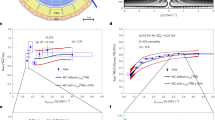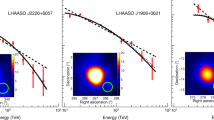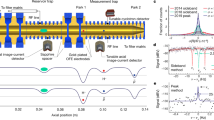Abstract
THE existence of anti-matter in the universe has intrigued astrophysicists for quite some time. Several authors have suggested the existence and creation of anti-matter at various places in the universe1,2. One way of attempting to verify such possibilities is to see if cosmic rays, which include nuclei accelerated from various regions of our galaxy (if not the whole universe), contain anti-nuclei. Alfven1, however, argues that cosmic rays at the Earth may not contain anti-nuclei for various reasons. Even if this were so, cosmic rays should contain secondary anti-protons produced in collisions of cosmic ray protons with interstellar hydrogen. Estimates of the abundance of secondary anti-protons have been made by several authors: Fradkin3 gives a value (p̄/p)∼5 × 10−4 for anti-protons of energy Ep > 1.7 GeV; Milford and Rosen4 estimate that for Ep∼0.5 GeV, (p̄/p)⪍3 × 10−3 and more recently by calculating the energy spectrum of such anti-protons they state5 (the numbers are not published to my knowledge) that the ratio (p̄/p) at low energies may be greater by several orders of magnitudes than that calculated at high energies.
This is a preview of subscription content, access via your institution
Access options
Subscribe to this journal
Receive 51 print issues and online access
$199.00 per year
only $3.90 per issue
Buy this article
- Purchase on Springer Link
- Instant access to full article PDF
Prices may be subject to local taxes which are calculated during checkout
Similar content being viewed by others
References
Alfven, H., Rev. Mod. Phys., 37, 652 (1965).
Hoyle, F., and Narlikar, J. V., Proc. Roy. Soc., A, 290, 143 (1966).
Fradkin, M. I., JET P, 29, 147 (1955).
Milford, S. N., and Rosen, S., Nature, 205, 582 (1965).
Rosen, S., and Milford, S. N., Bull. Amer. Phys. Soc., 11, 399 (1966).
Haskin, D. M., et al., Proc. Moscow CR Conf., 3, 123 (1960).
Aizu, K., Fujimoto, Y., Hasegawa, S., Koshiba, M., Mito, I., Nishimura, J., Yokoi, K., and Schien, M., Phys. Rev., 121, 1206 (1961).
Grigorov, N. L., Zhuravlev, D. A., Kondrateva, M. A., Rapoport, I. D., and Savenko, I. A., Artificial Earth Satellites, 9/10, 232 (1962).
Powell, C. F., Fowler, P. H., and Perkins, D. H., The Study of Elementary Particles by the Photographic Method (Pergamon Press, London, 1959).
Frier, P., and Waddington, C. J., Univ. Minn. Tech. Rep. CR73 (1964).
Author information
Authors and Affiliations
Rights and permissions
About this article
Cite this article
APPARAO, M. Upper Limit on the Abundance of Anti-protons in the Low Energy Galactic Cosmic Radiation. Nature 215, 727–728 (1967). https://doi.org/10.1038/215727b0
Received:
Published:
Issue Date:
DOI: https://doi.org/10.1038/215727b0
This article is cited by
-
Propagation of cosmic rays in the galaxy
Space Science Reviews (1975)
-
Rigidity Spectrum of Helium Nuclei above 17 GV and a Search for High Energy Anti-nuclei in Primary Cosmic Rays
Nature Physical Science (1972)
-
Age of Cosmic Rays and Abundance of Antimatter in the Galaxy
Nature (1970)
-
The size of antimatter bodies and the primary very high energy cosmic ray flux
Astrophysics and Space Science (1970)
-
Matter traversal of high-energy primary cosmic rays from antiproton measurements
Lettere al Nuovo Cimento (1969)
Comments
By submitting a comment you agree to abide by our Terms and Community Guidelines. If you find something abusive or that does not comply with our terms or guidelines please flag it as inappropriate.



